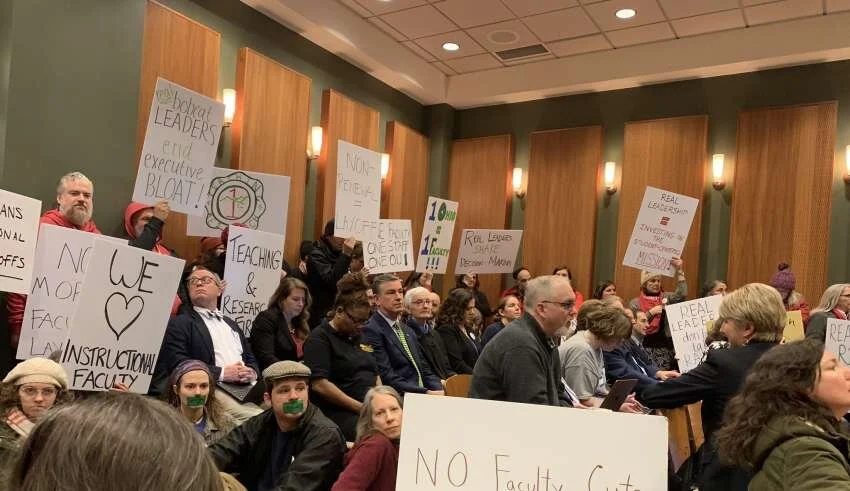Ohio U faculty silently protest job cuts at public meeting
The protest moved into the Walter Hall meeting room where some faculty covered their mouths with green tape. Photo by Maggie Prosser.
[dropcap txtcolor="#234a83" style="dropcap1"]T[/dropcap]he Ohio University Board of Trustees met Friday morning for their January meeting, where Ohio U faculty made clear their dissatisfaction with the board’s recent budgetary decisions, all without saying a word.
Last Friday, the Ohio U chapter of the American Association of University Professors (AAUP) sent a message to faculty members to encourage them to gather ahead of the Board of Trustees’ meeting to protest budgetary choices, which includes an ever-growing number of senior administrative members that they believe would “significantly damage OU’s academic mission, cut faculty lines, and expand executive administrative bloat.”
At 9:15 on Friday morning, about 50 faculty members arrived in Grover Hall to show their concerns. Many were dressed in red -- the color of AAUP -- and carried protest signs that sported messages such as “we love our instructional faculty” and “responsible leadership = honest accounting.”
While members of the public were able to attend the Board of Trustees meeting, they could not comment, so the faculty kept their protest silent. They also said their silence was partially representative of how they felt “silenced” by the decisions of the administration. Some participants also put tape over their mouths to add to the message of silence.
Thomas Scanlan, an associate professor of English at Ohio U, turned out for the protest due to his personal concerns over the past choices of the Board of Trustees and to express what he wanted from the Board’s future actions.
“I’m disturbed by the direction the university seems to be taking,” Scanlan said. “We should keep the academic mission front and center, and the president doesn’t seem to be keeping with that.”
Daniel Torres, a professor of Spanish and Latin American studies, also showed up for the protest. While Torres is a full professor and is protected from the recent faculty layoffs, he has seen five people in his department lose their jobs and is worried about the possibility of more faculty being laid off in the future.
“I’m concerned about my colleagues that might lose their job,” Torres said. “ We have administrators making six figures who could save so many people.”
After their initial gathering, the faculty protestors went to Walter Hall to sit in at the beginning of the Board of Trustees’ meeting. Five minutes after the meeting began, the faculty protesters walked out of the meeting room and started to shout “Whose university? Our university!” from the hallway.
One of the most anticipated decisions of the morning came when the Board of Trustees approved a movement introduced by the Governing and Compensation committee to implement early retirement plans for tenured professors and associate professors, as well as custodial staff.
The only additional comment on the decision came from Student Trustee Austin McClean, who made sure to assert a student perspective after the vote.
“Every financial decision that is made, we have to ask if we are willing to put our students into debt,” McClean said.
AAUP previously sent a letter in December to Ohio U President Duane Nellis asking both him to make a public commitment to faculty and the academic mission of the university.
While Nellis said he supports Ohio U's mission to facilitate free speech, he did not say much about budgetary concerns during the meeting. Instead, he spent the majority of his speaking time highlighting notable research and activities at Ohio U, including his recent meetings with several department deans in addition to work that had been done with the Open OHIO initiative.
Still, the topic of money did not seem to be missed by any members of the Board of Trustees. During his time, Nellis presented a chart that displayed the yearly net worth of the highest-earning companies in the world in order to illustrate the economy that students enter after graduation. Upon seeing the numbers on the chart, another board member jokingly asked Nellis “is that your 401(k)?” to which Nellis responded, “I wish.” Nellis made $489,357 last year.
Other votes at the meeting included the approval of Ohio U foundation investments and endowments, funding rebuilding and repairs for buildings on the Athens, Dublin, Lancaster and Chillicothe campuses and assigning resources for the Voinovich scholars program and athletics departments.
Despite not speaking a word inside the room, the largest presence were the faculty protesters, who all seemed to express both frustrations at the current situation and hope for the future.
“I hope the Board of Trustees understand that there are people that care about the university’s future, and we are a resource to be used, not stepped over or pushed aside,” Scalan said.
Most of all, the faculty present at the meeting wanted to express their own voices while also setting an example to inspire other voices to be heard on campus.
“It’s also a moment to teach our students to stand up for their rights.” Torres said. “I hope they hear our voice and think hard about what they’re doing. Education is our future, and in democracy you have to make your voice heard.”

